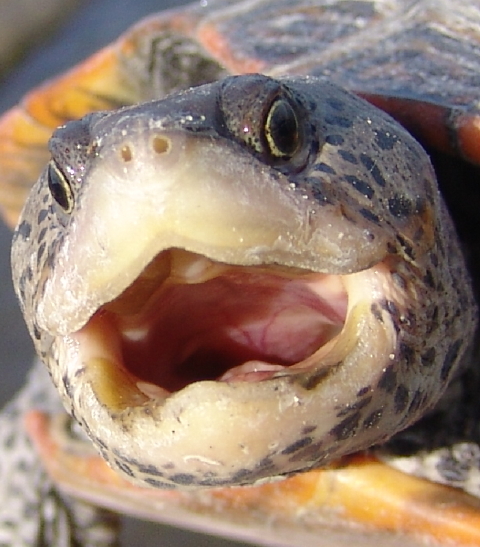Seven-Year-Old Female Diamondback Terrapin #35
The Turtle Journal team discovered a sweet 7-year-old female diamondback terrapin who had joined the Sippican Harbor mating aggregation this season. A 2005 hatchling, this lovel young lady disappeared during the “lost (juvenile) years,” only to resurface today as a fully grown adult who will help restore the severely threatened Buzzards Bay population.Â
Female Terrapin #35Â Snorkeling in Sippican Harbor
As we paddled kayaks into the Head of Sippican Harbor, we spotted a couple of terrapins snorkeling in the mid afternoon sunshine. In a few weeks, as water temperatures rise, this mating area will be filled with many male and female turtles looking love. Today, only a handful of terrapins are active. Capturing even one will be a challenge.
Sue Wieber Nourse Turtling by Kayak in Sippican Harbor
Netting terrapins from a kayak is a high skill activity in the best of conditions. Today hardly qualified as best conditions with a stiff southerly breeze whipping up wave action and stirring the water into a frothy mocha latte. Game for the challenge, Sue Wieber Nourse charged toward the snorkeling turtle with net at the ready.
Sue Wieber Nourse Net Female Terrapin #35
She smoothly guided the kayak into position and swooped up the turtle racing across the bottom of the harbor. This gorgeous young female proved a new recruit to the adult terrapin population, a young 7-year-old female who had just reached sexual maturity and will be nesting for the first time this year.
Sue Wieber Nourse and Female Diamondback Terrapin #35
Back on shore, we measured and marked her as diamondback terrapin #35. Her shell measured nearly 7 inches long and 5.6 inches wide. It’s interesting to contrast her with Cape Cod terrapins that don’t reach maturity until at least one year later and yet are still nearly an inch shorter in length.
Sue Wieber Nourse Release Female Terrapin #35
We welcomed this newest recruit to the adult terrapin population of Buzzards Bay and released her back into Sippican Harbor. We hope to find her nesting in early June to continue the cycle and to save her offspring to join the Sippican mating aggregation in 2021.



























